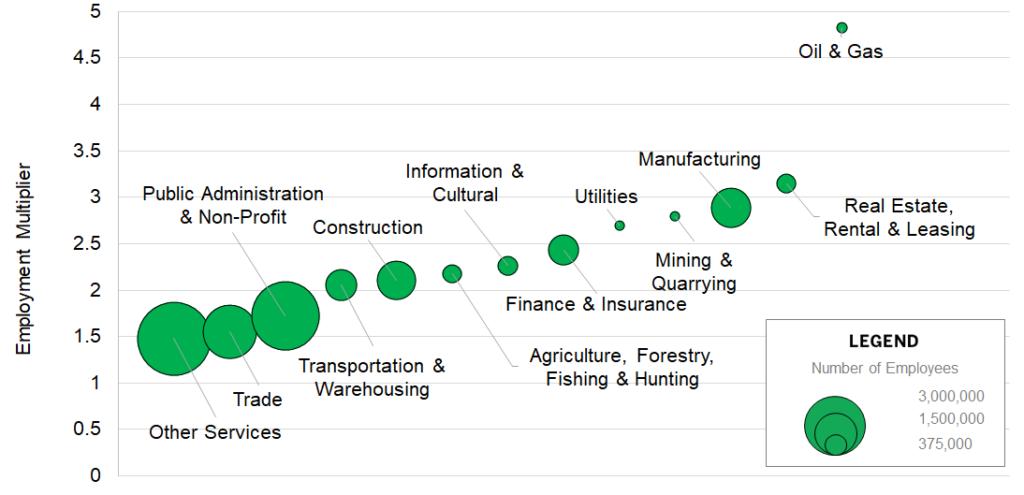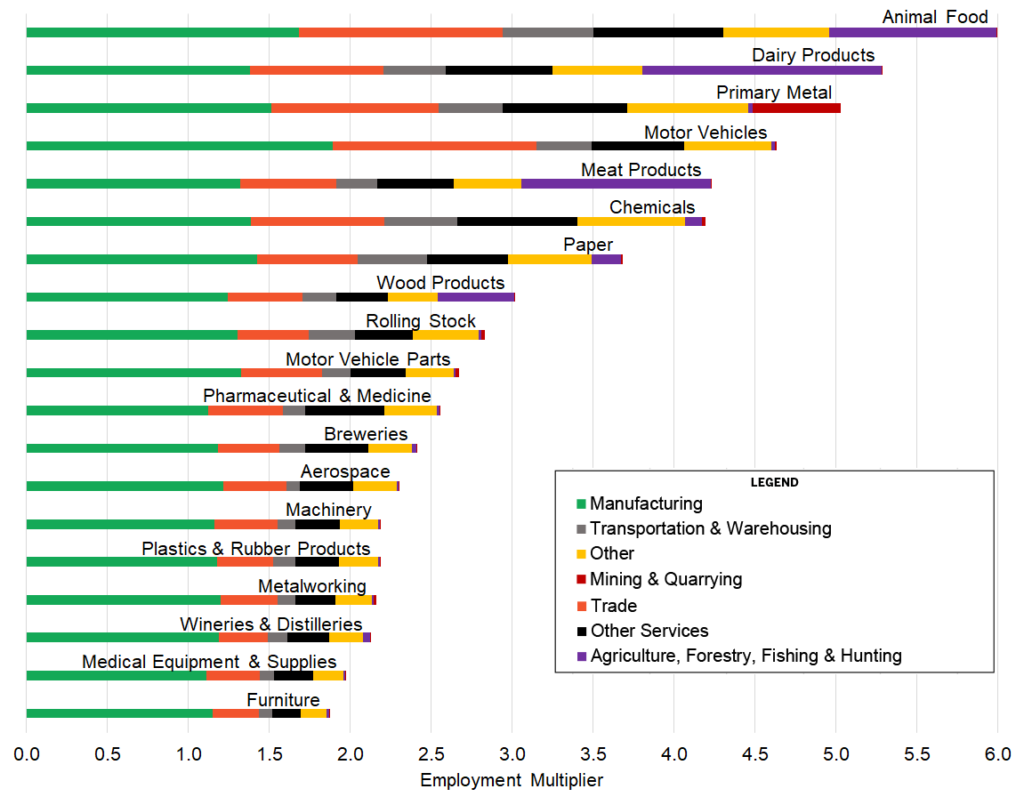Manufacturing makes outsized contributions to Canada’s economy. In addition to generating more than $750 billion in output and contributing nearly $200 billion to GDP annually while directly employing more than 1.5 million people, manufacturing generates significant spin-off benefits. These benefits are captured using economic multipliers, the focus of the sixth in our series of manufacturing data bulletins.
Economic multipliers capture three types of economic effects: direct, indirect, and induced 1:
- Direct effects are those associated with employment, expenditures, and production in any given industry. The employment at a vehicle assembly plant and the expenditures that the vehicle manufacturer makes when assembling a vehicle are direct effects of vehicle manufacturing.
- Indirect effects are those associated with the economic activity created in preceding stages of production. For example, if a motor vehicle manufacturer purchases seats from a local seat manufacturer, the employment and spending associated with the seat manufacturer is considered an indirect effect of motor vehicle manufacturing.
- Induced effects are those driven by household expenditures associated with direct and indirect activities. When the employees of the vehicle and seat manufacturers buy groceries, fuel, furniture, clothing, and other goods and services, they are contributing to the induced effects associated with motor vehicle manufacturing.
The bulletin examines employment multiplier effects specifically. Employment multipliers estimate the total number of jobs created by direct, indirect, and induced activities for any given industry. Figure 1 illustrates the employment multiplier effects associated with 12 different sectors, including manufacturing, as well as the number of persons employed in each. 2
Figure 1 – Employment Multipliers and Number of Employees, Select Canadian Industries

Figure 1 shows that the employment multiplier effects of manufacturing are among the highest of any sector. This is due to the substantial purchases of goods and services by manufacturers and the significant value-added by manufacturing activities.
Multiplier effects differ considerably across specific manufacturing industries. Those that are most productive, offer relatively high wages, and source a substantial proportion of goods and services within Canada have the highest multipliers. Figure 2 illustrates the multiplier effects across a range of manufacturing industries. It also illustrates the sectors in which direct, indirect and induced employment are created as a result of specific manufacturing activities.
Several food processing industries have high economic multipliers. This is because they rely extensively on Canadian farmers and a majority of their products are sold in Canada. This is similar, albeit on a smaller scale, for wood and paper product manufacturers.
Figure 2 – Employment Multipliers by Sector, Select Manufacturing Industries

Capital intensive continuous process industries, such as primary metal and chemical manufacturing, have high economic multipliers. This is due to their high rates of productivity and output, reliance on local service suppliers (e.g. maintenance and trades), and high wages.
Motor vehicle manufacturing also has a high economic multiplier. This is due to high levels of productivity, wages, and the industry’s reliance on a complex network of parts, components, materials, and value-added service suppliers. The multiplier effects associated with vehicle manufacturing were once the highest of all industries outside of oil and gas. However, these effects decreased over the past decade due to a significant increase in motor vehicle parts imports, including the powertrain modules that are installed in Canadian-made vehicles.
For the next decade or longer, the multiplier benefits associated with motor vehicle manufacturing in Canada will be closely related to investments in the electric vehicle battery supply chain. The more domestic content–including batteries, battery materials, and raw materials (e.g. lithium, nickel, cobalt)–included in Canadian-made vehicles, the higher the multiplier benefits derived from motor vehicle manufacturing will be.
1 Statistics Canada’s input-output tables provide detailed information on inter-industry transactions, which are used to calculate economic multipliers. The bulletin draws upon these data to examine the total economic impact of manufacturing relative to other sectors (i.e. sum of direct, indirect and induced effects). It also compares the economic impact of different segments of manufacturing in Canada.
2 Employment data is sourced from Statistics Canada Table 36-10-0480-01 (formerly CANSIM 383-0033).
Key takeaways:
- Economic multipliers are a useful tool to observe and quantify the economic impact of different sectors of Canada’s economy.
- Manufacturing has a high economic multiplier and thus makes outsized contributions to Canada’s economy.
- The multiplier effects differ considerably across different segments of manufacturing.
- Manufacturing industries that offer high wages, are very productive, and are closely integrated with Canadian agriculture and natural resource extraction industries, as well as with other segments of Canadian manufacturing, have the highest multiplier effects.